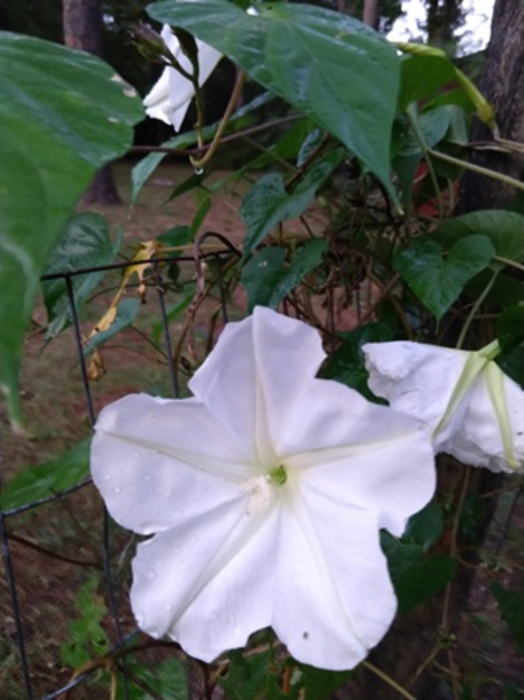Ask Master Gardener Volunteer Linda Clemens
Last night, I counted 15 moonflowers blooming on the fence around the vegetable garden. The huge white flowers, 6 to 8 inches in diameter, open at sunset and close again in the morning. Their sweet scent attracts night feeding moths, including the hummingbird moth, which really does look and sound just like a hummingbird. With all those huge white blooms, I am irresistibly reminded of the white sheets hanging on the clothes lines of my childhood.

The moonflower (Ipomoea alba) is a native Florida blooming vine and is a perennial in USDA Hardiness Zones 9 and 10. Here in Wakulla County (Zone 8b and 9a), it is grown as an annual. The vine can reach lengths of up to 15 feet during the growing season. Moonflowers grow best in full sun and need a support for their twining vines. The large heart-shaped leaves are attractive and give visual interest before the plant blooms appear.
The plant starts to bloom in late July and flowers continuously until cold weather. I like to grow it on the fence around the vegetable garden to provide some interest after most of the summer’s vegetables are harvested and gone.
I grow my moonflowers from seed each year. I first bought a packet of seeds several years ago and have saved seeds from each crop to use the following year ever since. Seeds are commonly available and can generally be found in the seed racks at hardware, home improvement, or garden stores.
I start my moonflowers in February by first nicking the seeds on some fine sandpaper (scarification), then soaking them in warm water overnight. They are sown using regular potting soil in seed flats placed on a heating mat. They stay inside under grow lights, then in the greenhouse until the weather is warm. I transplant the young plants to the garden once the soil warms up in mid to late April. Plants grow slowly at first and take off with hot weather. Seeds maybe sown in the ground, but you should still nick and soak them overnight. Flowering will be delayed with direct planting.
By October, the moonflower vine will stop blooming and concentrate on setting and ripening seed. I collect the seed pods and air-dry them to shell out the seeds. I keep the seeds at room temperature in a plastic container, ready to plant next spring.
For more information about moonflowers, see the Florida Native Plant Society webpage at: https://www.fnps.org/plants/plant/ipomoea-alba. If you don’t have full sun or would like other options for vines, please check out Flowering Vines for Florida at https://edis.ifas.ufl.edu/pdffiles/MG/MG09700.pdf.
If you have any questions or suggestions for future articles please email to wakullamg@ifas.ufl.edu
| The Institute of Food and Agricultural Sciences (IFAS) is an Equal Opportunity Institution authorized to provide research, educational information, and other services only to individuals and institutions that function with non-discrimination with respect to race, creed, color, religion, age, disability, sex, sexual orientation, marital status, national origin, political opinions, or affiliations. U.S. Department of Agriculture, Cooperative Extension Service, University of Florida, IFAS, Florida A&M University Cooperative Extension Program, and Boards of County Commissioners Cooperating |
 0
0


